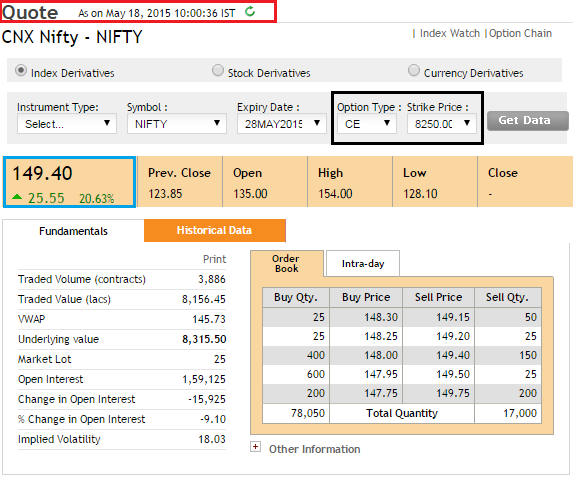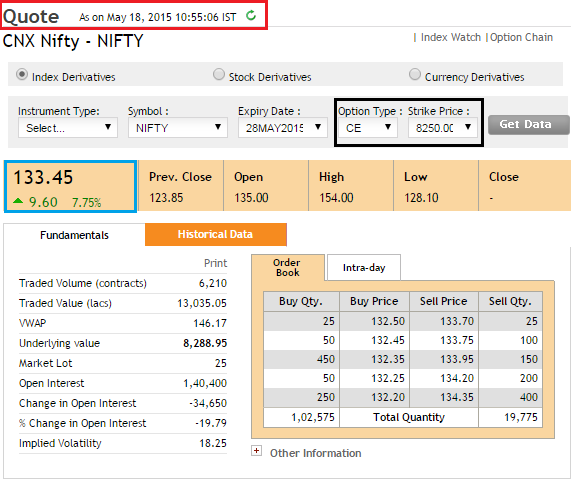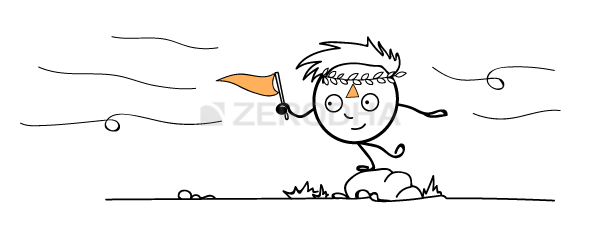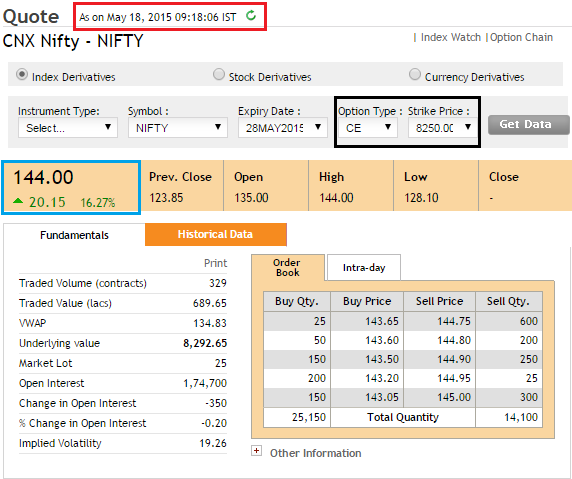9.1 – Overview
Yesterday I watched the latest bollywood flick ‘Piku’. Quite nice I must say. After watching the movie I was casually pondering over what really made me like Piku – was it the overall storyline, or Amitabh Bachchan’s brilliant acting, or Deepika Padukone’s charming screen presence, or Shoojit Sircar’s brilliant direction? Well, I suppose it was a mix of all these factors that made the movie enjoyable.
This also made me realize, there is a remarkable similarity between a bollywood movie and an options trade. Similar to a bollywood movie, for an options trade to be successful in the market there are several forces which need to work in the option trader’s favor. These forces are collectively called ‘The Option Greeks’. These forces influence an option contract in real time, affecting the premium to either increase or decrease on a minute by minute basis. To make matters complicated, these forces not only influence the premiums directly but also influence each another.
To put this in perspective think about these two bollywood actors – Aamir Khan and Salman Khan. Movie buffs would recognize them as two independent acting forces (similar to option Greeks) of Bollywood. They can independently influence the outcome of the movie they act in (think of the movie as an options premium). However if you put both these guys in a single flick, chances are that they will try to pull one another down while at the same time push themselves up and at the same time try to make the movie a success. Do you see the juggling around here? This may not be a perfect analogy, but I hope it gives you a sense of what I’m trying to convey.
Options Premiums, options Greeks, and the natural demand supply situation of the markets influence each other. Though all these factors work as independent agents, yet they are all intervened with one another. The final outcome of this mixture can be assessed in the option’s premium. For an options trader, assessing the variation in premium is most important. He needs to develop a sense for how these factors play out before setting up an option trade.
 So without much ado, let me introduce the Greeks to you –
So without much ado, let me introduce the Greeks to you –
- Delta – Measures the rate of change of options premium based on the directional movement of the underlying
- Gamma – Rate of change of delta itself
- Vega – Rate of change of premium based on change in volatility
- Theta – Measures the impact on premium based on time left for expiry
We will discuss these Greeks over the next few chapters. The focus of this chapter is to understand the Delta.
9.2 – Delta of an Option
Notice the following two snapshots here – they belong to Nifty’s 8250 CE option. The first snapshot was taken at 09:18 AM when Nifty spot was at 8292.

Now notice the change in premium – at 09:18 AM when Nifty was at 8292 the call option was trading at 144, however at 10:00 AM Nifty moved to 8315 and the same call option was trading at 150.
In fact here is another snapshot at 10:55 AM – Nifty declined to 8288 and so did the option premium (declined to 133).

From the above observations one thing stands out very clear – as and when the value of the spot changes, so does the option premium. More precisely as we already know – the call option premium increases with the increase in the spot value and vice versa.
Keeping this in perspective, imagine this – you have predicted that Nifty will reach 8355 by 3:00 PM today. From the snapshots above we know that the premium will certainly change – but by how much? What is the likely value of the 8250 CE premium if Nifty reaches 8355?
Well, this is exactly where the ‘Delta of an Option’ comes handy. The Delta measures how an options value changes with respect to the change in the underlying. In simpler terms, the Delta of an option helps us answer questions of this sort – “By how many points will the option premium change for every 1 point change in the underlying?”
Therefore the Option Greek’s ‘Delta’ captures the effect of the directional movement of the market on the Option’s premium.

The delta is a number which varies –
- Between 0 and 1 for a call option, some traders prefer to use the 0 to 100 scale. So the delta value of 0.55 on 0 to 1 scale is equivalent to 55 on the 0 to 100 scale.
- Between -1 and 0 (-100 to 0) for a put option. So the delta value of -0.4 on the -1 to 0 scale is equivalent to -40 on the -100 to 0 scale
- We will soon understand why the put option’s delta has a negative value associated with it
At this stage I want to give you an orientation of how this chapter will shape up, please do keep this at the back of your mind as I believe it will help you join the dots better –
- We will understand how we can use the Delta value for Call Options
- A quick note on how the Delta values are arrived at
- Understand how we can use the Delta value for Put Options
- Delta Characteristics – Delta vs. Spot, Delta Acceleration (continued in next chapter)
- Option positions in terms of Delta (continued in next chapter)
So let’s hit the road!
9.3 – Delta for a Call Option
We know the delta is a number that ranges between 0 and 1. Assume a call option has a delta of 0.3 or 30 – what does this mean?
Well, as we know the delta measures the rate of change of premium for every unit change in the underlying. So a delta of 0.3 indicates that for every 1 point change in the underlying, the premium is likely change by 0.3 units, or for every 100 point change in the underlying the premium is likely to change by 30 points.
The following example should help you understand this better –
Nifty @ 10:55 AM is at 8288
Option Strike = 8250 Call Option
Premium = 133
Delta of the option = + 0.55
Nifty @ 3:15 PM is expected to reach 8310
What is the likely option premium value at 3:15 PM?
Well, this is fairly easy to calculate. We know the Delta of the option is 0.55, which means for every 1 point change in the underlying the premium is expected to change by 0.55 points.
We are expecting the underlying to change by 22 points (8310 – 8288), hence the premium is supposed to increase by
= 22*0.55
= 12.1
Therefore the new option premium is expected to trade around 145.1 (133+12.1)
Which is the sum of old premium + expected change in premium
Let us pick another case – what if one anticipates a drop in Nifty? What will happen to the premium? Let us figure that out –
Nifty @ 10:55 AM is at 8288
Option Strike = 8250 Call Option
Premium = 133
Delta of the option = 0.55
Nifty @ 3:15 PM is expected to reach 8200
What is the likely premium value at 3:15 PM?
We are expecting Nifty to decline by – 88 points (8200 – 8288), hence the change in premium will be –
= – 88 * 0.55
= – 48.4
Therefore the premium is expected to trade around
= 133 – 48.4
= 84.6 (new premium value)
As you can see from the above two examples, the delta helps us evaluate the premium value based on the directional move in the underlying. This is extremely useful information to have while trading options. For example assume you expect a massive 100 point up move on Nifty, and based on this expectation you decide to buy an option. There are two Call options and you need to decide which one to buy.
Call Option 1 has a delta of 0.05
Call Option 2 has a delta of 0.2
Now the question is, which option will you buy?
Let us do some math to answer this –
Change in underlying = 100 points
Call option 1 Delta = 0.05
Change in premium for call option 1 = 100 * 0.05
= 5
Call option 2 Delta = 0.2
Change in premium for call option 2 = 100 * 0.2
= 20
As you can see the same 100 point move in the underlying has different effects on different options. In this case clearly the trader would be better off buying Call Option 2. This should give you a hint – the delta helps you select the right option strike to trade. But of course there are more dimensions to this, which we will explore soon.
At this stage let me post a very important question – Why is the delta value for a call option bound by 0 and 1? Why can’t the call option’s delta go beyond 0 and 1?
To help understand this, let us look at 2 scenarios wherein I will purposely keep the delta value above 1 and below 0.
Scenario 1: Delta greater than 1 for a call option
Nifty @ 10:55 AM at 8268
Option Strike = 8250 Call Option
Premium = 133
Delta of the option = 1.5 (purposely keeping it above 1)
Nifty @ 3:15 PM is expected to reach 8310
What is the likely premium value at 3:15 PM?
Change in Nifty = 42 points
Therefore the change in premium (considering the delta is 1.5)
= 1.5*42
= 63
Do you notice that? The answer suggests that for a 42 point change in the underlying, the value of premium is increasing by 63 points! In other words, the option is gaining more value than the underlying itself. Remember the option is a derivative contract, it derives its value from its respective underlying, hence it can never move faster than the underlying.
If the delta is 1 (which is the maximum delta value) it signifies that the option is moving in line with the underlying which is acceptable, but a value higher than 1 does not make sense. For this reason the delta of an option is fixed to a maximum value of 1 or 100.
Let us extend the same logic to figure out why the delta of a call option is lower bound to 0.
Scenario 2: Delta lesser than 0 for a call option
Nifty @ 10:55 AM at 8288
Option Strike = 8300 Call Option
Premium = 9
Delta of the option = – 0.2 (have purposely changed the value to below 0, hence negative delta)
Nifty @ 3:15 PM is expected to reach 8200
What is the likely premium value at 3:15 PM?
Change in Nifty = 88 points (8288 -8200)
Therefore the change in premium (considering the delta is -0.2)
= -0.2*88
= -17.6
For a moment we will assume this is true, therefore new premium will be
= -17.6 + 9
= – 8.6
As you can see in this case, when the delta of a call option goes below 0, there is a possibility for the premium to go below 0, which is impossible. At this point do recollect the premium irrespective of a call or put can never be negative. Hence for this reason, the delta of a call option is lower bound to zero.
9.4 – Who decides the value of the Delta?
The value of the delta is one of the many outputs from the Black & Scholes option pricing formula. As I have mentioned earlier in this module, the B&S formula takes in a bunch of inputs and gives out a few key outputs. The output includes the option’s delta value and other Greeks. After discussing all the Greeks, we will also go through the B&S formula to strengthen our understanding on options. However for now, you need to be aware that the delta and other Greeks are market driven values and are computed by the B&S formula.
However here is a table which will help you identify the approximate delta value for a given option –
| Option Type | Approx Delta value (CE) | Approx Delta value (PE) |
|---|---|---|
| Deep ITM | Between + 0.8 to + 1 | Between – 0.8 to – 1 |
| Slightly ITM | Between + 0.6 to + 1 | Between – 0.6 to – 1 |
| ATM | Between + 0.45 to + 0.55 | Between – 0.45 to – 0.55 |
| Slightly OTM | Between + 0.45 to + 0.3 | Between – 0.45 to -0.3 |
| Deep OTM | Between + 0.3 to + 0 | Between – 0.3 to – 0 |
Of course you can always find out the exact delta of an option by using a B&S option pricing calculator.
9.5 – Delta for a Put Option
Do recollect the Delta of a Put Option ranges from -1 to 0. The negative sign is just to illustrate the fact that when the underlying gains in value, the value of premium goes down. Keeping this in mind, consider the following details –
| Parameters | Values |
|---|---|
| Underlying | Nifty |
| Strike | 8300 |
| Spot value | 8268 |
| Premium | 128 |
| Delta | -0.55 |
| Expected Nifty Value (Case 1) | 8310 |
| Expected Nifty Value (Case 2) | 8230 |
Note – 8268 is a slightly ITM option, hence the delta is around -0.55 (as indicated from the table above).
The objective is to evaluate the new premium value considering the delta value to be -0.55. Do pay attention to the calculations made below.
Case 1: Nifty is expected to move to 8310
Expected change = 8310 – 8268
= 42
Delta = – 0.55
= -0.55*42
= -23.1
Current Premium = 128
New Premium = 128 -23.1
= 104.9
Here I’m subtracting the value of delta since I know that the value of a Put option declines when the underlying value increases.
Case 2: Nifty is expected to move to 8230
Expected change = 8268 – 8230
= 38
Delta = – 0.55
= -0.55*38
= -20.9
Current Premium = 128
New Premium = 128 + 20.9
= 148.9
Here I’m adding the value of delta since I know that the value of a Put option gains when the underlying value decreases.
I hope with the above two Illustrations you are now clear on how to use the Put Option’s delta value to evaluate the new premium value. Also, I will take the liberty to skip explaining why the Put Option’s delta is bound between -1 and 0.
In fact I would encourage the readers to apply the same logic we used while understanding why the call option’s delta is bound between 0 and 1, to understand why Put option’s delta is bound between -1 and 0.
In the next chapter we will dig deeper into Delta and understand some of its characteristics.
Key takeaways from this chapter
- Option Greeks are forces that influence the premium of an option
- Delta is an Option Greek that captures the effect of the direction of the market
- Call option delta varies between 0 and 1, some traders prefer to use 0 to 100.
- Put option delta varies between -1 and 0 (-100 to 0)
- The negative delta value for a Put Option indicates that the option premium and underlying value moves in the opposite direction
- ATM options have a delta of 0.5
- ITM option have a delta of close to 1
- OTM options have a delta of close to 0.



Hi kartik,
Very very thanks for new chapter. Contents are very good and clear but incomplete knowledge create confusion. So, I am waiting with Patience for your completing this module.
Thanks for you patience, we are working on the new chapter…will put up up as soon as we can.
hey Nikhil ,i have learnt alot from zerodha varsity. While going through this chapter and solving examples a doubt arose.it would be great if you could look into it.
In the example of call option where you talk about the role delta plays when one expects nifty to drop and the example where you take delta below 0. in these two case there is certain differences in computation of premium. i believe as per the computation in first example ,in later example it should have been
change in nifty= 8200-8288= -88
expected change in premium =
-88*(-0.2) = 17.6
hence new premium shall be 9+17.6=26.6
please look into it.and let me know if i have misunderstood the concept
Glad to note that, Jyotsana. By the way, the way to determine the change in Delta is by calculating the change in Nifty points multiplied by the Delta….so in this case –
88*0.2 = 17.6.
If you are long Call, add the delta to the premium, if you are short call, deduct the delta from the premium. Do not consider the algebraic sign at the time of calculating the change in delta. Easier this way 🙂
Ok,thanks I had a similar question ,which I have posted below.Of course we have to consider the premium both from a writer and buyer perspective..doubt cleared.
Ah, glad you figured 🙂
BS has been known to be erroneous for NIFTY (Asian Journal for Management) , how does one trust the Greeks then ? Is there a modification in BS Formula to consider the NIFTY.
Well, in that case, no model is perfect 🙂 I’m not sure if there is a variant which fits Nifty well. I need to check this.
Sir
Thank you very much for explaining the difficult subject in easy way. It’s really appreciable & thank you once again for taking so much pain to explain rather complicated things.
Keep it up. Awaiting eagerly for next chapters.
waiting for next chapter …..
hey first of all thanks for explaining the delta in such a simple way.
when will be the chapter on option strategies will come?
The module on Option stratergies will take some time…we will start work on that once the ongoing module on Options Theory is through.
If i sell first a stock at 25 and then buy at 20 before expiry , then my profit is 5 plus premium received. Am i right?
Let me rephrase this – If you sell an option (not stock) at a premium of 25 and buy the option back at 20, then the profit you make is Rs.5/- times the lot size”.
why not premium received?
Can you please elaborate your query, I’m unable to understand the context. Thanks.
You may have already realized answer to your question. If not, you received Rs25/- premium for selling the call option, which is already considered in the calculation, right ?
profit=(25-20)*lot size —- assuming you bought same number of contracts (lots), which you should be doing.